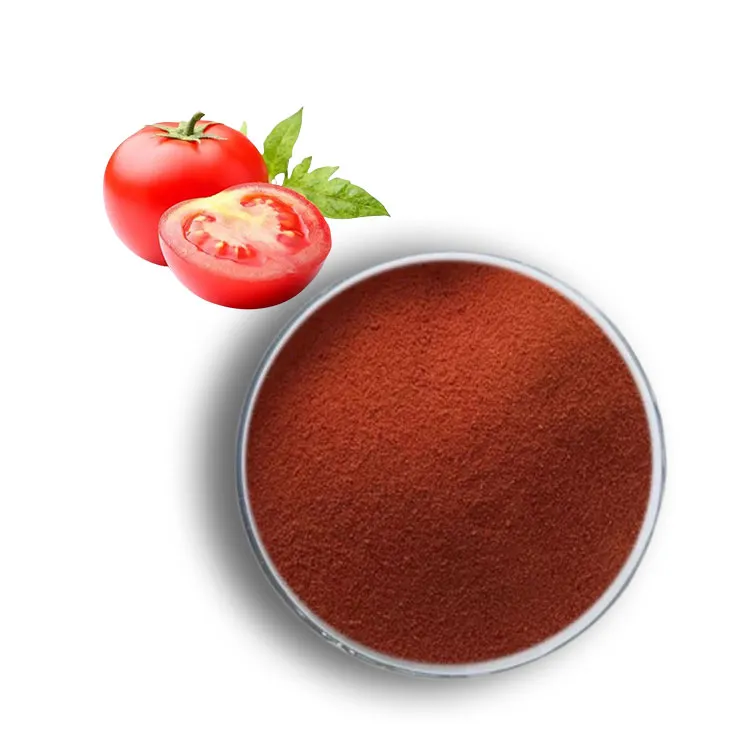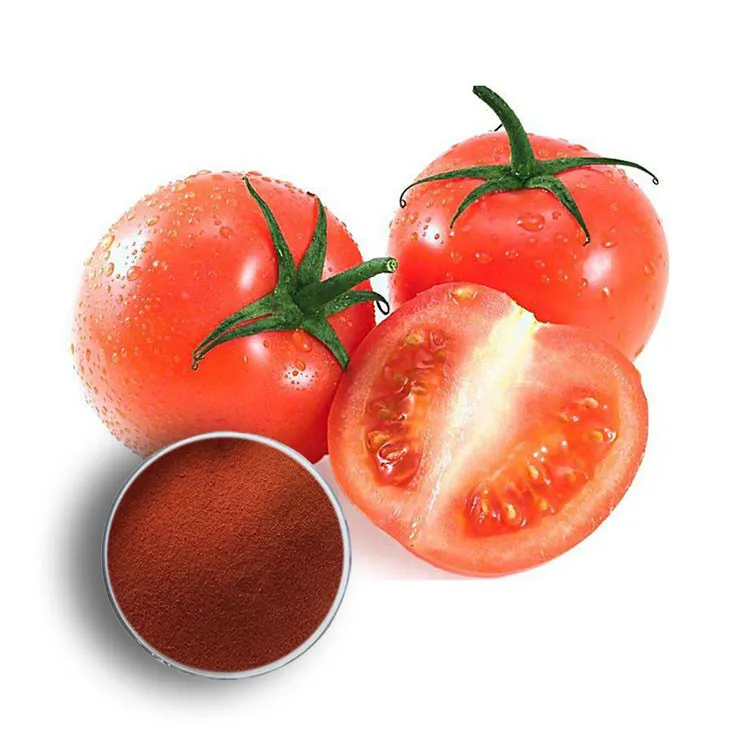- 0086-571-85302990
- sales@greenskybio.com
Lycopene manufacturer.
2024-11-29

Introduction to Lycopene
Lycopene, a powerful antioxidant, has gained significant popularity in recent years. It is a carotenoid pigment that gives tomatoes their characteristic red color. However, its importance extends far beyond just the color of tomatoes. Lycopene has been associated with numerous health benefits, including reducing the risk of certain cancers, heart diseases, and macular degeneration.

The Role of Lycopene Manufacturers
Lycopene manufacturers play a crucial role in meeting the growing demand for this beneficial compound. They are at the heart of the supply chain, ensuring that lycopene is available for use in various industries such as dietary supplements, functional foods, and cosmetics.

Raw Material Sourcing
The manufacturing process of lycopene starts from the sourcing of high - quality tomatoes. This is a fundamental step as the quality of the raw material directly impacts the quality of the final lycopene product.
Collaboration with Farmers
Manufacturers often collaborate with farmers to ensure a consistent supply of raw materials. This collaboration involves several aspects:
- Providing technical support to farmers on tomato cultivation techniques. This can include advice on proper irrigation, fertilization, and pest control methods to ensure healthy tomato plants.
- Establishing quality standards for the tomatoes to be supplied. For example, setting criteria for the size, color, and ripeness of tomatoes to ensure that they are suitable for lycopene extraction.
- Entering into long - term contracts with farmers. This gives farmers the assurance of a market for their produce and provides manufacturers with a stable supply of tomatoes.

Extraction Techniques
Advanced extraction techniques are employed to isolate lycopene from tomatoes. There are different methods available, each with its own advantages and disadvantages.
Solvent - Based Extraction
Some manufacturers use solvent - based extraction methods. In this process:
- Tomatoes are first crushed to form a pulp. This helps to break down the cell walls and release the lycopene.
- A suitable solvent, such as hexane or ethyl acetate, is added to the pulp. The solvent has the ability to dissolve lycopene and other compounds.
- The mixture is then stirred or agitated to ensure thorough mixing of the solvent and the tomato pulp.
- After a certain period of time, the solvent - lycopene mixture is separated from the remaining solid parts of the tomato. This can be done through filtration or centrifugation.
- The solvent is then evaporated to obtain the lycopene extract. However, this method has some drawbacks. The use of solvents may pose environmental and safety concerns. Residual solvents in the final product may also affect its quality and safety.
Supercritical Fluid Extraction
Others are exploring more environmentally friendly and efficient alternatives like supercritical fluid extraction. Here's how it works:
- A supercritical fluid, typically carbon dioxide, is used. Carbon dioxide is preferred because it is non - toxic, non - flammable, and has a relatively low critical temperature and pressure.
- The tomatoes are placed in a high - pressure vessel along with the supercritical carbon dioxide. At supercritical conditions, the carbon dioxide has properties of both a liquid and a gas, which allows it to effectively dissolve lycopene.
- The lycopene - rich supercritical fluid is then separated from the tomatoes. This can be achieved by changing the pressure or temperature of the system, causing the carbon dioxide to return to its gaseous state and leaving behind the lycopene.
- Supercritical fluid extraction has several advantages. It is a more "green" process as it does not leave behind harmful solvent residues. It also offers better selectivity in extracting lycopene, resulting in a purer product.
Quality Control
Quality control is of utmost importance in the manufacturing process. Manufacturers need to ensure that the lycopene they produce meets strict purity and potency standards.
Testing at Different Stages
This involves rigorous testing at various stages of production:
- Raw material testing: Before the tomatoes are used for extraction, they are tested for their lycopene content, as well as for the presence of contaminants such as pesticides, heavy metals, and mycotoxins. Only tomatoes that meet the quality requirements are used in the manufacturing process.
- During - process testing: During the extraction and purification steps, samples are taken at regular intervals to monitor the progress of the process. Parameters such as the concentration of lycopene in the extract, the amount of impurities, and the efficiency of the extraction are measured.
- Final product testing: Once the lycopene product is obtained, it undergoes comprehensive testing. This includes determining its purity, potency, and stability. The product is also tested for its compliance with regulatory requirements regarding safety and quality.
Product Innovation
Lycopene manufacturers also focus on product innovation. They are constantly researching ways to improve the bioavailability of lycopene, which refers to the proportion of the ingested lycopene that is absorbed and available for use in the body.
Encapsulation
One approach is through encapsulation. Encapsulation involves enclosing the lycopene in a protective shell or matrix. This has several benefits:
- Protection from degradation: The encapsulation material protects lycopene from environmental factors such as light, oxygen, and heat, which can cause it to degrade. This helps to maintain the stability and potency of lycopene during storage and transportation.
- Improved solubility: Some encapsulation materials can improve the solubility of lycopene in different solvents or in the gastrointestinal tract. This can enhance its absorption in the body.
- Controlled release: Encapsulation can be designed to release lycopene in a controlled manner. For example, it can be engineered to release lycopene in the small intestine, where absorption is more likely to occur.
Formulation with Other Substances
Another way to improve bioavailability is by formulating lycopene with other substances. For example:
- Combining with lipids: Lycopene is a lipophilic compound, and formulating it with lipids can enhance its absorption. Lipids can help to solubilize lycopene and facilitate its passage through the cell membranes in the gut.
- Adding emulsifiers: Emulsifiers can be added to improve the dispersion of lycopene in aqueous systems. This is important for applications in foods and beverages where lycopene needs to be evenly distributed.
Applications of Lycopene in Different Industries
The innovative efforts of lycopene manufacturers have expanded the potential applications of lycopene in various industries.
Dietary Supplements
Lycopene is widely used in dietary supplements. Due to its antioxidant properties, it is often promoted as a supplement to support overall health. Manufacturers are constantly looking for ways to improve the formulation of lycopene - based supplements to increase their effectiveness and consumer acceptance.
Functional Foods
In functional foods, lycopene is added to enhance the nutritional value of the product. For example, it can be added to tomato - based products such as ketchup, pasta sauce, or tomato juice. Manufacturers need to ensure that the addition of lycopene does not affect the taste, texture, or shelf - life of the food product.
Cosmetics
Lycopene is also finding applications in the cosmetics industry. Its antioxidant properties make it suitable for use in anti - aging creams, lotions, and serums. Manufacturers are exploring ways to incorporate lycopene into cosmetic formulations in a stable and effective manner.
Future Trends in Lycopene Manufacturing
The field of lycopene manufacturing is expected to see several trends in the future.
Improved Extraction Technologies
There will be continuous research and development to improve extraction technologies. This may include the development of more efficient and environmentally friendly extraction methods. For example, new solvents or extraction processes that can further reduce the cost and environmental impact while increasing the yield and quality of lycopene.
Expansion of Applications
The applications of lycopene are likely to expand further. There may be new developments in the use of lycopene in the pharmaceutical industry, for example, in the treatment or prevention of specific diseases. Additionally, its use in the food and cosmetics industries may also be further diversified.
Global Market Growth
As awareness of the health benefits of lycopene continues to grow, the global market for lycopene products is expected to expand. This will drive manufacturers to increase their production capacity and improve their competitiveness through innovation and cost - control measures.
FAQ:
What are the main sources of raw materials for lycopene manufacturers?
For lycopene manufacturers, the main source of raw materials is high - quality tomatoes. They often collaborate with farmers to ensure a consistent supply of tomatoes.
What extraction methods do lycopene manufacturers use?
Some lycopene manufacturers use solvent - based extraction methods. However, others are exploring more environmentally friendly and efficient alternatives such as supercritical fluid extraction.
Why is quality control important for lycopene manufacturers?
Quality control is of utmost importance for lycopene manufacturers because they need to ensure that the lycopene they produce meets strict purity and potency standards. This requires rigorous testing at various stages of production.
What do lycopene manufacturers do for product innovation?
Lycopene manufacturers are constantly researching ways to improve the bioavailability of lycopene. For example, they may use encapsulation or formulate lycopene with other substances. This enables better absorption in the human body and expands the potential applications of lycopene in areas like dietary supplements, functional foods, and cosmetics.
What are the potential applications of lycopene?
Lycopene has potential applications in areas such as dietary supplements, functional foods, and cosmetics. Thanks to product innovation by manufacturers which aims to improve its bioavailability, it can be better absorbed in the human body, making it suitable for these applications.
Related literature
- Lycopene Production and its Applications in the Food Industry"
- "The Role of Lycopene Manufacturers in the Global Market"
- "Advances in Lycopene Extraction Technologies by Manufacturers"
- ▶ Hesperidin
- ▶ citrus bioflavonoids
- ▶ plant extract
- ▶ lycopene
- ▶ Diosmin
- ▶ Grape seed extract
- ▶ Sea buckthorn Juice Powder
- ▶ Beetroot powder
- ▶ Hops Extract
- ▶ Artichoke Extract
- ▶ Reishi mushroom extract
- ▶ Astaxanthin
- ▶ Green Tea Extract
- ▶ Curcumin Extract
- ▶ Horse Chestnut Extract
- ▶ Other Problems
- ▶ Boswellia Serrata Extract
- ▶ Resveratrol Extract
- ▶ Marigold Extract
- ▶ Grape Leaf Extract
- ▶ blog3
- ▶ blog4
-
Standard - process Nutmeg extract.
2024-11-29
-
The best honeysuckle pollen on the market.
2024-11-29
-
The Best Rosemary Extract in 2024.
2024-11-29
-
The best - quality feverfew extract.
2024-11-29
-
The best organic aged garlic extract.
2024-11-29
-
Bilberry Extract
2024-11-29
-
Acai Berry Extract
2024-11-29
-
Kidney Bean Extract
2024-11-29
-
Green coffee bean Extract
2024-11-29
-
Hericium erinaceus extract powder
2024-11-29
-
Oat Straw Extract Powder
2024-11-29
-
Hesperidin
2024-11-29
-
Eyebright Extract
2024-11-29
-
Beta Carotene
2024-11-29
-
Shikone Extract
2024-11-29





















